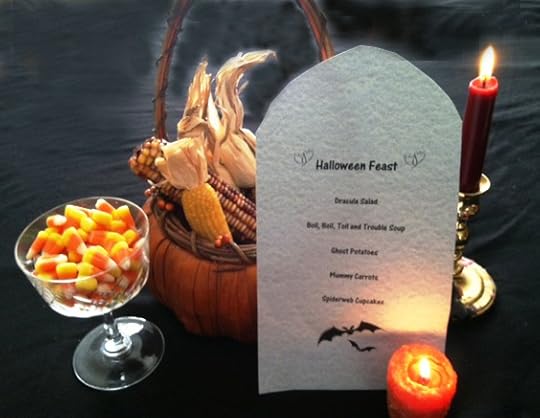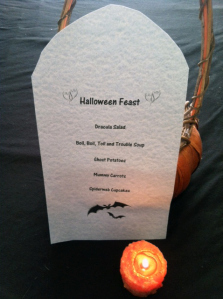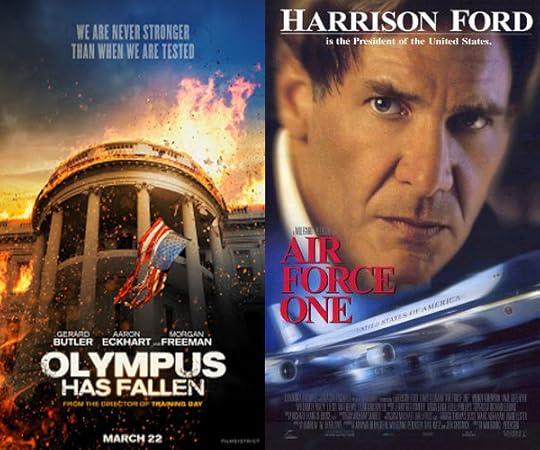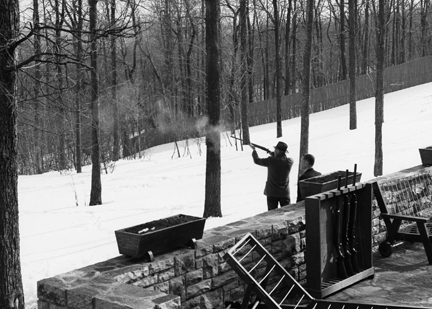Dee Garretson's Blog, page 7
February 27, 2015
For Authors: School Visits are a Good Opportunity to Embrace Your Odd
I was shocked to read Shannon Hale���s post about her experiences during school visits, where sometimes only girls are expected to attend, because Shannon writes what are labeled ���girl��� books. Here’s her post if you haven’t read it: http://shannonhale.tumblr.com/post/112152808785/no-boys-allowed-school-visits-as-a-woman-writer
I don���t have that problem, because apparently I write ���boy��� books. I get a different sort of reaction during school visits, but more about that later. I didn���t realize there was such a thing as ���boy��� and ���girl��� books when I started writing. My first book felt like it should be written from the POV of a twelve-year-old boy, so that���s what I did. It didn���t occur to me as it would be considered an odd choice by some. I wrote my second book from a boy���s POV too. I���ve discovered that for whatever reason, I liked telling some of my stories that way.
I know I don���t look the part of an author who writes adventure stories featuring boys. I sometimes get very surprised reactions during school and Skype visits when I tell the students about myself: how much of a Lord of the Rings geek I am, how I love science fiction and adventure movies, and how sometimes I would rather be outside instead of writing. Apparently, these are boy characteristics in our society, not middle-aged suburban mom characteristics. (Yes, I am a suburban middle-aged mom, not one of the Kool Kidz, but wow, do I click with teachers and librarians, something that seems to escape some marketing considerations.)
After the surprise though, I can see some students out in the audience who light up and become more engaged in my talks. I suspect it���s those who have been feeling like they don���t fit in, for whatever reason. Schools can be hard places for odd kids. Though I loved school, there were some who considered me strange. It didn���t bother me, because I came from a family where quirkyness was normal. (My father was the perfect stereotype of an eccentric inventor.) I know many children find their oddness a burden though. They don���t realize their quirks may be their greatest strength later in life. I know I never would have become a writer without mine.
I���d encourage other authors to let kids know about your own quirks. Don���t try to fit the mold of ���successful children���s author who writes _______(fill in the blank)��� Show them you aren’t a stereotype. Tell them if you were an odd kid. They’ll find it interesting. Your reader don���t care if you fit a mold or not. I’ve decided that if by sharing things about myself,��I can help just one kid to feel a little better about themselves, that���s a good day. My new motto is ���Odd is Good.���

February 11, 2014
Sidekick Characters – C3PO���s role in Star Wars
 I���ve learned so much about storytelling from studying the original Star Wars��� movies-as well as given myself an excuse to watch movies as part of my job-and one of the things I���ve discovered is the value of a good sidekick character. There are many different kinds of sidekicks, and they can serve different purposes. C3PO is great as a sidekick for many reasons. First, he���s not what we expect. Though most of us have no idea what a sentient android would act like, I can bet no one pre-Star Wars imagined one as a nervous fusspot with a bit of an ego. Too often a sidekick is the friend who is there only to give the main character someone to talk to, and that���s just boring. Sidekicks need distinct personalities of their own, and their own goals and conflicts. C3PO certainly has a distinct personality and his goal is to do his job as an interpreter droid, but his conflict is that he is thrown into very dangerous situations that go against his expected role.
I���ve learned so much about storytelling from studying the original Star Wars��� movies-as well as given myself an excuse to watch movies as part of my job-and one of the things I���ve discovered is the value of a good sidekick character. There are many different kinds of sidekicks, and they can serve different purposes. C3PO is great as a sidekick for many reasons. First, he���s not what we expect. Though most of us have no idea what a sentient android would act like, I can bet no one pre-Star Wars imagined one as a nervous fusspot with a bit of an ego. Too often a sidekick is the friend who is there only to give the main character someone to talk to, and that���s just boring. Sidekicks need distinct personalities of their own, and their own goals and conflicts. C3PO certainly has a distinct personality and his goal is to do his job as an interpreter droid, but his conflict is that he is thrown into very dangerous situations that go against his expected role.
Second, a good sidekick can provide an alternative perspective on situations that arise. C3PO acts as a contrast to the brave main characters of Star Wars, who leap into danger without a thought. It���s C3PO who often acts more human than Han, Leia and Luke, something the viewer doesn���t expect. Androids aren���t supposed to experience fear. A good example of this is the scene in which he is afraid to go outside the Millennium Falcon when it���s inside the space slug. When he says, ���I think it might be better if I stay here and guard the ship,��� he���s not only saying what a normal person would probably want to say, he���s also unintentionally funny. And that���s CEPOs third strength as a sidekick. A little humor can add tremendous value to an adventure, to modulate the tension, and to make the viewers (or readers) want to be part of the action. C3PO doesn���t know he���s funny, and that makes him even funnier. The audience knows he is incapable of guarding anything.
While C3PO particular blend of characteristics couldn���t and shouldn���t be duplicated, considering why the character works so well reminds me to take care in creating my own sidekick characters.


Sidekick Characters – C3PO’s role in Star Wars
 I’ve learned so much about storytelling from studying the original Star Wars’ movies-as well as given myself an excuse to watch movies as part of my job-and one of the things I’ve discovered is the value of a good sidekick character. There are many different kinds of sidekicks, and they can serve different purposes. C3PO is great as a sidekick for many reasons. First, he’s not what we expect. Though most of us have no idea what a sentient android would act like, I can bet no one pre-Star Wars imagined one as a nervous fusspot with a bit of an ego. Too often a sidekick is the friend who is there only to give the main character someone to talk to, and that’s just boring. Sidekicks need distinct personalities of their own, and their own goals and conflicts. C3PO certainly has a distinct personality and his goal is to do his job as an interpreter droid, but his conflict is that he is thrown into very dangerous situations that go against his expected role.
I’ve learned so much about storytelling from studying the original Star Wars’ movies-as well as given myself an excuse to watch movies as part of my job-and one of the things I’ve discovered is the value of a good sidekick character. There are many different kinds of sidekicks, and they can serve different purposes. C3PO is great as a sidekick for many reasons. First, he’s not what we expect. Though most of us have no idea what a sentient android would act like, I can bet no one pre-Star Wars imagined one as a nervous fusspot with a bit of an ego. Too often a sidekick is the friend who is there only to give the main character someone to talk to, and that’s just boring. Sidekicks need distinct personalities of their own, and their own goals and conflicts. C3PO certainly has a distinct personality and his goal is to do his job as an interpreter droid, but his conflict is that he is thrown into very dangerous situations that go against his expected role.
Second, a good sidekick can provide an alternative perspective on situations that arise. C3PO acts as a contrast to the brave main characters of Star Wars, who leap into danger without a thought. It’s C3PO who often acts more human than Han, Leia and Luke, something the viewer doesn’t expect. Androids aren’t supposed to experience fear. A good example of this is the scene in which he is afraid to go outside the Millennium Falcon when it’s inside the space slug. When he says, “I think it might be better if I stay here and guard the ship,” he’s not only saying what a normal person would probably want to say, he’s also unintentionally funny. And that’s CEPOs third strength as a sidekick. A little humor can add tremendous value to an adventure, to modulate the tension, and to make the viewers (or readers) want to be part of the action. C3PO doesn’t know he’s funny, and that makes him even funnier. The audience knows he is incapable of guarding anything.
While C3PO particular blend of characteristics couldn’t and shouldn’t be duplicated, considering why the character works so well reminds me to take care in creating my own sidekick characters.


January 30, 2014
Great Writing Advice from Kurt Vonnegut
 I found these two tips from Kurt Vonnegut which really struck me:
I found these two tips from Kurt Vonnegut which really struck me:
Every character should want something, even if it is only a glass of water.
Every sentence must do one of two things — reveal character or advance the action.(from Vonnegut’s book BAGOMBO SNUFF BOX: UNCOLLECTED SHORT FICTION)
This advice seems so simple, but is so easily forgotten. Tip 1 is most useful when writing a first draft and figuring out the characters. It’s too easy to add in a character to help the plot, but without fully fleshing out that character. I’ve been guilty of this myself. Not anymore!
And for the second tip, what a great thought to keep in mind when revising. Knowing how to revise is a long learning process, and getting the pacing right is vital, so analyzing the purpose of each sentence will cut down on unnecessary bits that drag the story down.
Bagombo Snuff Box: Uncollected Short Fiction


January 22, 2014
Why I Encourage Beginning Writers to Write Fan Fiction
 I do frequent Skype visits with classes, and often the students are working on creative writing units. As a parent and a parent volunteer in classrooms, I know creative writing isn’t easy for a large number of students. It just seems overwhelming to some to pull together characters, plot, setting and theme. That’s why I recommend new writers try their hand at fan fiction. Now, I didn’t even know what fan fiction was until about four years ago when I heard other writers discussing it. So for those of you who don’t know what it is either, here’s a brief description: Fan fiction is where you use the characters or world in an already published book or television show or movie, to write stories set in the same world or with the same characters. It’s not fiction to be published, unless the original work is out of copyright, or is something that has never been copyrighted, like fairy tales.
I do frequent Skype visits with classes, and often the students are working on creative writing units. As a parent and a parent volunteer in classrooms, I know creative writing isn’t easy for a large number of students. It just seems overwhelming to some to pull together characters, plot, setting and theme. That’s why I recommend new writers try their hand at fan fiction. Now, I didn’t even know what fan fiction was until about four years ago when I heard other writers discussing it. So for those of you who don’t know what it is either, here’s a brief description: Fan fiction is where you use the characters or world in an already published book or television show or movie, to write stories set in the same world or with the same characters. It’s not fiction to be published, unless the original work is out of copyright, or is something that has never been copyrighted, like fairy tales.
A writer writes fan fiction because they love the world of the story and want to see it continue. It’s also an excellent way to practice writing. Many published writers got their start writing fan fiction. The benefits of it are that a new writer doesn’t have so much to juggle. Using existing characters gives a basis. You know the character’s habits, quirks, friendships, etc., so you can focus on plot. This can take some of the pressure off. And if the world of the story is already a complicated one, like the one in Harry Potter, you can add details but don’t have to embark upon the complicated task of worldbuilding, something else that is very daunting and difficult for new writers.
So if you are a writer, child or adult, struggling with writing, why not give it a try? And keep in mind, writing only improves with practice, it doesn’t ever get worse!


October 28, 2013
Spooky Halloween Dinner for Vegetarians – Menu and Recipes
Here’s a very easy menu for a simple Halloween Dinner, vegetarian style. And as a bonus, at the end of the post is a link to my old-fashioned ghost story you can print out and read aloud at your party to set the mood. I’m not crazy about disgusting-looking food, even for Halloween, so I chose food my family would actually eat. No pseudo-brains! Besides dessert, most of the items can be made at least partly in advance. In fact, it’s best to give yourself some time to cook both the carrots and potatoes so that there is enough time to cool them to finish the preparation.
The menu was printed out on gray textured paper with a couple of Word clip art Halloween themed pictures, and then cut in the shape of a tombstone:
Dracula Salad
Boil, Boil, Toil and Trouble Soup
Ghost Potatoes
Mummy Carrots
Spiderweb Cupcakes
1 bunch red-leafed lettuce (I used a spring mix, so I’ve got some green in mine.)
1/8 cup diced marinated beets per salad
1 Tablespoon diced red onion per salad
1 cut up cooked red new potato per salad
1 Tablespoon dried cranberries per salad
Arrange on plate and serve with Italian dressing, and goat cheese (if preferred.)
 Boil, Boil, Toil and Trouble Soup
Boil, Boil, Toil and Trouble Soup
Black Bean Soup:
3 cans black beans, drained and rinsed
1 can vegetable broth
1 onion, diced
5 stalks celery, diced
1 clove garlic, diced
1 tsp. celery salt
1 tsp. pepper
1 tsp. thyme
1 tsp. oregano
salt to taste
Saute onion, celery and garlic until softened. Place all ingredients in a large saucepan, bring to a boil, then reduce heat and simmer for twenty minutes. Makes 5 servings.
2 large baking potatoes ( choose long ones with one end more narrow than the other)
1 tablespoon butter, melted
2 tablespoons milk
4 tablespoons sour cream
4 pitted black olives
Cook potatoes in oven or microwave until softened. Let cool until you can handle them. Cut off the more rounded end and set aside for another use. With remaining piece, cut in half lengthwise so you have two ghost shapes. Scoop out potato carefully, preserving skins. Mash potato with milk and butter. Place potato back into skins, smoothing the filling flat. When ready to serve, cut olives into slices for eyes and mouth, reheat potatoes, when hot, spread sour cream on them like frosting, place eyes and mouth and serve. Makes four servings.
4 large carrots
1/2 cup orange juice
1 package (4 count crescent rolls)
8 dried cranberries
Cut narrow ends off carrots so that you are left with pieces that are about five inches in length. (Use the cutoff bits another time.) Cook carrots until semi tender in orange juice (i cooked them for about 4 minutes in a microwave.) Let cool enough to handle. Preheat oven according to directions on the crescent roll package. For each carrot, cut one crescent roll into strips and wrap around carrot, leaving a little space near the top for eyes. Bake according to package directions. While the mummies are baking, cut the cranberries down to make the eyes. (Use the extra bits on the Dracula salad.) As soon as the carrots are done, place on a serving plate and put cranberry eyes in place. Enjoy!
I don’t have a good picture of the spiderweb cupcakes, but will try to post one soon.
Here’s a link to the ghost story, BENEATH THE LAKE: http://deegarretson.com/ghoststory.html


October 23, 2013
ALLEGIANT by Veronica Roth and Readers’ Expectations
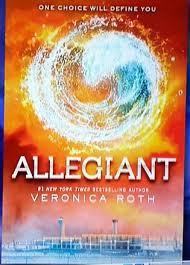 Spoiler Alert! Don’t read this post if you want to be surprised by the book.
Spoiler Alert! Don’t read this post if you want to be surprised by the book.
My thirteen-year-old daughter woke up early on Tuesday so she could start reading ALLEGIANT before school. A teenager purposely getting up early on a school day is a very telling sign of how eagerly she was awaiting this book, having loved the first two books in the DIVERGENT trilogy. She hasn’t gotten to the ending yet, and I know she is going to be both angry and disappointed.
We talk a lot about books in our house, and why authors make the choices they do. My daughter understands writers have reasons for every sentence in a story, and some of the choices a writer makes are not at all what a reader expects.
I’m looking at the choices Ms. Roth made from two different perspectives. As a writer myself, I’m all for seeing your vision through, and standing by what you set out to accomplish. I’ve fought to keep certain aspects in my books that I thought were important, and I think I made the stories stronger by doing so. I’ve had readers question why I had secondary characters die, and I know some of the readers are upset by the choices I’ve made.
On the other hand, as a parent of two voracious teen readers, I wonder how writers of middle grade and young adult fiction should deal with young readers’ expectations. My older son is reading G.R.R. Martin’s GAME OF THRONES. He’s on the third book, and he hasn’t yet reached the Red Wedding. He’s going to be horribly disappointed in that as well, but since it’s adult fiction, I’ve warned him things will not turn out as he expects.
Young adult fiction has few taboos left, and that is a good thing. Many teens are exposed to the grittiness and sorrow and death in the real world, and even if they aren’t, they need to know the world is not a happy place filled with bunnies and unicorns and rainbows. But readers read for specific reasons, and some readers choose books because they want a temporary escape from reality. That’s the reason I read. I don’t want to read something that makes me weep excessively. I don’t want to spend my time getting invested in a character only to see them die.
So what are teens expecting from this book going into it? It’s labeled as dystopian science fiction and as romance, and that sets up some expectations. Adult readers of science fiction know that stories can go in any direction, and teens probably shouldn’t expect that every YA sci fi will turn out with a triumphant main character defeating evil and moving on to a happy life. Though I have to say both my son and I prefer that kind of science fiction. Think of STAR WARS. Would the trilogy be so beloved if Luke died at the end?
ALLEGIANT is called a romance as well. Here is where the problem arises. Yes, ROMEO AND JULIET was a romance too, and a tragic one at that, but modern standards for what is and isn’t a romance have changed. We usually expect a happy ending, even if it isn’t exactly the one we envisioned. We do expect the main character to at least survive!
I’m mostly sad that I can predict this will not be a series my daughter reads over and over, as she does some of her favorites. I love seeing her in love with a book. And I’m also fairly sure she won’t want to see the movie. Maybe when she is older, she will come back to these books and understand the choices the author made. This had been a reminder for me that authors should think carefully about their readers’ expectations and make sure they know the consequences of their choices.
So I’ll just end as conflicted as I began this post. Good for Ms. Roth for writing the story she wanted to write, but I’ll sorry for the disappointed reader who waited months for this book.


October 17, 2013
What do these writers have in common? They taught me how to write.

Jane Austen, Mary Stewart and Martha Grimes
One of the most frequent questions I’m asked on school visits is what a person can do to become a writer. The easy answer is to read as much as possible, and to write, write, write. But that’s not all of it. When I first started writing, I had been a voracious reader for a long time, in fact, ever since I learned to read. I also wrote stories as a child, and as an adult, struggled to write full length novels. It wasn’t until I started studying the books I loved, that I took that big step to becoming a real storyteller. I will never stop working on my storytelling technique, because there is always more to learn, but I wanted to talk about those books that first made me understand the nature of pulling in a reader.
 Mary Stewart Merlin trilogy is a set of books I reread at least once a year. The first book in the series, THE CRYSTAL CAVE, is the one I read to remind myself of Ms. Stewart’s writing techniques. She is terrific at world-building, and at bringing the reader in with all the senses. Here are a few sentences from the opening chapter:
Mary Stewart Merlin trilogy is a set of books I reread at least once a year. The first book in the series, THE CRYSTAL CAVE, is the one I read to remind myself of Ms. Stewart’s writing techniques. She is terrific at world-building, and at bringing the reader in with all the senses. Here are a few sentences from the opening chapter:
“My mother was sitting at her loom; I remember the cloth; it was of scarlet, with a narrow pattern of green at the edge. I sat near her on the floor, playing knuckle-bones, right hand against left. The sun slanted through the windows, making oblong pools of bright gold on the cracked mosaics of the floor; bees droned in the herbs outside, and even the click and rattle of the loom sounded sleepy.”
I’ve always loved those lines because I can picture that scene so clearly in my head, it feels like I could be sitting there as well.
When I’m revising my own stories, I go back chapter by chapter and ask myself how I’ve engaged the reader’s senses. In every chapter there is a way to bring in not only sight, but at least one example of sound, scent, taste, or touch.
 An author who helped me understand character development is Martha Grimes, a mystery writer who has been named a Grand Master by the Mystery Writers of America. I’ve read all her Richard Jury mysteries, and when I was first struggling with writing, I asked myself an important question: Why exactly do I love Ms. Jury’s books over all the other hundreds of mysteries I’d read?
An author who helped me understand character development is Martha Grimes, a mystery writer who has been named a Grand Master by the Mystery Writers of America. I’ve read all her Richard Jury mysteries, and when I was first struggling with writing, I asked myself an important question: Why exactly do I love Ms. Jury’s books over all the other hundreds of mysteries I’d read?
She’s a master at creating characters so vivid, I want to meet them. Well, at least some of them. The Aunt Agatha in the series is the relative we all hope we never have. Her main characters, Melrose Plant and Richard Jury are both complex, interesting and unique. In the first three chapters of THE MAN WITH A LOAD OF MISCHIEF, the reader learns all about the personality, background, and character of Melrose Plant in a seamless manner woven into the plot. The next chapters switch to Richard Jury and do the same thing. I love the way she describes the secondary characters as well. Here’s her description of a local constable, Constable Pluck:
“Pluck was thin to the point of emaciation, but he had a cherubic, rosy face, made even rosier by winter’s bite, so that he looked like an apple on a stick. But he was a good man, if a bit of a gossip.”
Martha Grimes also uses subtle touches of humor, which I’ve discovered is one of the keys to what makes me love a book. For example, in later books, the constant battle between Scotland Yard Superintendent Racer and the cat that has the run of the place is a nice touch. It highlights the personality of the obnoxious Racer, and it’s fun to read as well.
 Jane Austen in PRIDE AND PREJUDICE uses light touches of humor to great effect too, but for me, one of her main strengths is her ability to use dialog to both move the plot along and to establish character. I’ve always loved Mr. Bennet’s lines in the opening chapter when he’s speaking to Mrs. Bennet: “I have a high respect for you nerves. They are my old friends. I have heard you mention them with consideration these twenty years at least.” These few lines tell a reader so much about both characters and their relationship with each other.
Jane Austen in PRIDE AND PREJUDICE uses light touches of humor to great effect too, but for me, one of her main strengths is her ability to use dialog to both move the plot along and to establish character. I’ve always loved Mr. Bennet’s lines in the opening chapter when he’s speaking to Mrs. Bennet: “I have a high respect for you nerves. They are my old friends. I have heard you mention them with consideration these twenty years at least.” These few lines tell a reader so much about both characters and their relationship with each other.
There is a great deal of dialogue in the book and very little description of things like appearance, clothing and surroundings. I think the important lesson to take from this is that while scene setting is vital, it can also be very spare, depending on the book. Austen was writing for an audience who didn’t need much description to imagine the setting, because it was their immediate world. This is something to think about when writing a contemporary. Unless there is something unusual about the setting, great blocks of description may well slow the book down too much.
I do also have certain books that influence me for a specific writing project. DUNE was an enormous influence on the first of the science fiction trilogy I’m working on, but that influence is enough for a whole post of its own!
So my advice to writers pared down to one sentence is “Find a book you absolutely love, and figure out exactly why you love it.”
Happy Reading!


October 1, 2013
AIR FORCE ONE- Thumbs Up, OLYMPUS HAS FALLEN – Thumbs Down
Or “What I Learned about Writing from Watching Movies 1”
One question I am often asked during talks is how I made WILDFIRE RUN seem believable, even though the premise of a President’s son getting trapped at Camp David during a disaster is far-fetched, to say the least. Over the years I’ve studied many books to understand how the authors managed to make thrillers work, but I’ve also learned an equal amount from watching great movies. Analyzing movies has had a great impact on my writing. This post is part 1 of a new series on movie lessons learned for writers.
Quick Summary – In case you haven’t seen one or the other of these movies, here are the plots -
AIR FORCE ONE – While the President is aboard, Russian terrorists take control of Air Force One.
OLYMPUS HAS FALLEN – The President is inside the White House when a group of North Korean terrorists take over the building
Plausibility – the major factor!
Any writer of adventures or thrillers knows even if the scenarios are unlikely, they have to be somewhat believable for the reader or viewer to get fully engaged in the story.
The major flaw for me in both these stories is something too common in political thrillers – the presence of a former secret service agent turned traitor, who is crucial to the bad guys’ success. I don’t buy it. I buy that there are former secret services agents who weren’t great at their jobs, or who don’t share the same political philosophy of the presidents they protect. I don’t believe one would actively work to damage the U.S. government.
So given that each film gets one strike for lack of plausibility, why does Air Force One come out ahead? Let’s look at the other factors.
AIR FORCE ONE
1. A team of foreign journalists is allowed on Air Force One. At the time the movie came out, pre 9/11, it seemed possible, if unlikely, so maybe half a point taken away for implausibility.
2. The idea of an escape pod on the plane was probably the one plot point that stretched believability the most, but it was one of those elements where a viewer could think, “That would be a good idea!” Given that factor, another half point taken away
3. Lots of gunfire aboard that doesn’t damage the plane – I don’t know much about what a bullet hole would do to a plane’s ability to fly, but I have to believe it wouldn’t help, and there was so much gunfire, you’d think a stray bullet or two would have done some major damage. One point taken away.
4. The ending with the zip line between two planes. Totally unbelievable, but a cool scene. One point taken away, though it was fun to watch.
OLYMPUS HAS FALLEN
1. The protective force field on the bad guys’ plane prevents it from being shot down by the U.S. military, giving it time to do lots of damage. Completely unbelievable. This wasn’t Star Wars. One point taken away.
2. The President allows the South Korean prime minister and more unbelievable, the Prime Minister’s staff to go with him into the bunker. The Secret Service allows it. Just no. One point taken away.
3. There are far fewer bad guys than good guys when the White House is first attacked, yet the bad guys prevail. The secret service agents unthinkingly run out the front door shooting at the bad guys, allowing the bad guys to simply mow them down. No. One point taken away.
4. The President orders the Secretary of Defense to give up the missile code because he still has one and he’s not going to tell. Right. One point taken away.
5. At the end, even though officials know the bad guys are all dead, the Secret Service agent helps the President walk out the front door of the White House. No one meets them until they are on the front steps. A dramatic scene, but not very uplifting, and so the ridiculous elements took away any positive from the dramatic elements. Where are the medical personnel? Wouldn’t people rush in as soon as they could? Another point gone.
I could go on, but I don’t need to. AIR FORCE ONE ends up with a negative three, OLYMPUS HAS FALLEN has a negative five.
At some point, if the level of implausibility is too great, no amount of special effects or great actors can overcome the viewers’ (or readers’) disbelief.
There are other factors that weigh in too, not as important, but still worth considering.
Title
AIR FORCE ONE – A good title, probably fairly obvious it’s a political thriller
OLYMPUS HAS FALLEN – An unclear title and a negative one. Olympus could mean many things. Mount Olympus? Even if a potential movie goer realizes it’s a political thriller, it sounds depressing. People watch and read thrillers because they want them to end in some sort of victory. Something that is fallen is clearly not a victory.
Mood of the Audience
This is not something a writer can control, but knowledge of the general feelings of the population do factor in to what becomes popular and what fails. AIR FORCE ONE came out in 1997, long before 9/11, when though we knew the world was a dangerous and scary place, we were somewhat removed from it. The bad guys in the movie don’t manage to take over the plane in the U.S.-it happens in Russia, again, very removed from the United States.
OLYMPUS HAS FALLEN came out this year. I, for one, felt a little sick even watching the preview and seeing the White House damaged. I remember 9/11 too well, and I was hesitant to even watch this movie because of that. Timing in publishing is important too. Sometimes readers just aren’t in the mood for a certain kind of story.
Level of Violence versus Character Development
There was lots of violence in both movies, but the number of minutes devoted to violence was far less in AIR FORCE ONE, allowing for more character development. I cared more about the characters in AIR FORCE ONE. And for writers, getting your readers to care about your characters has to be the number one focus of the early part of a story. In OLYMPUS HAS FALLEN, I wish a little more time would have been devoted to the character development and the relationship between the characters in the beginning of the movie. The boxing scene didn’t anything for me in terms of my view of the characters.
So in summary, here are the important elements I took away:
Keep the plot as plausible, or at least as believable as possible.
The title is important, and consequently, the cover of a book as well.
Focus, focus, focus on making your readers care about the characters.
Judge the mood of your target audience.
Coming next – The great lessons for writers in the movie WAR GAMES


February 5, 2013
Skeet Shooting at Camp David over the years.
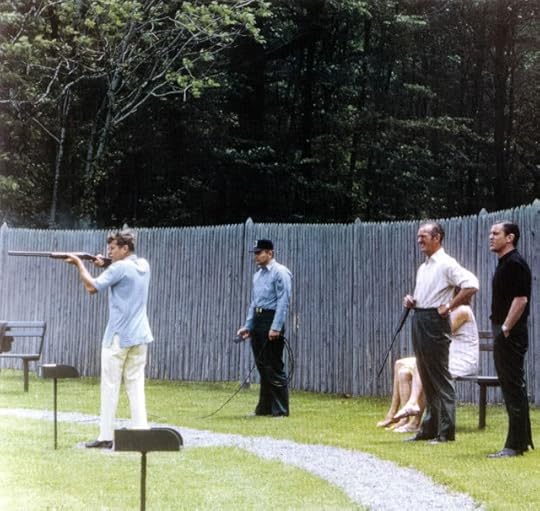
President Kennedy Skeet Shooting at Camp David
Researching Camp David to write WILDFIRE RUN was so fascinating that I’m always happy now to go back and have an excuse to focus on a specific part of the place. With the release of the photograph of President Obama skeet shooting at Camp David, I wanted to bring together some bits of history. I’ve never been skeet shooting myself, but I used to go with my dad while he and his friends did. I had forgotten about it until President Obama’s made the news.
There aren’t many photos of Presidents on the skeet range at Camp David, but I think this one of President Kennedy above is fascinating. He looks far more casual than we see him in most photos, especially with his shirt untucked. Jackie Kennedy came to Camp David for the horsebacking riding with her children, but since President Kennedy had a bad back and didn’t ride, skeet shooting was one activity he could enjoy.
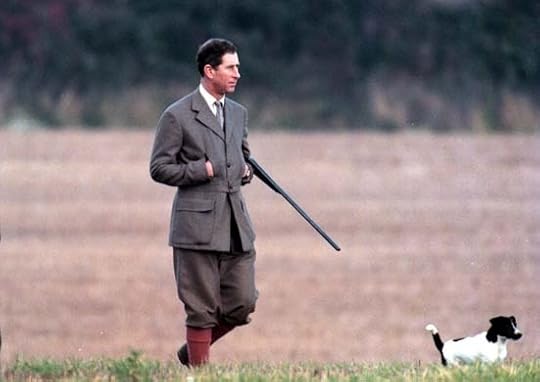
Prince Charles
I haven’t been able to find any photos of them at Camp David, but when Prince Charles and his sister, Princess Anne, visited the U.S. in 1970, they were taken there for “an evening of bicycing, skeet shooting, and swimming followed by hamburgers and steaks on the Aspen terrace followed by banana splits for dessert,” according to W. Dale Nelson, who wrote about the history of the place in THE PRESIDENT IS AT CAMP DAVID.
I’ve seen several photographs of Prince Charles hunting in Britain, so I assume he’s a good shot, but probably not as good as the Egyptian and Israeli security forces who accompanied Prime Minister Anwar Sadat and to Camp David when they were meeting with President Jimmy Carter to discuss a Middle East peace accord. Carter’s former press secretary, Jody Powell, said that he remembers shooting skeet with them, but he made no mention of how everyone did in comparison to those highly trained military men.
President Eisenhower also enjoyed shooting skeet there, and was reportedly quite good at it. I haven’t yet been able to find any photos of other presidents at the range, but I assume many have taken advantage of it, especially those who were hunters. I’m going to keep looking for references and will add if I find any.
If you know a reader in the 8 to 13 year old age range who likes adventure, you can find out more about WILDFIRE RUN, set at Camp David, by going to my website: http://deegarretson.com




